The problem of the appearance of groundwater on the plot is worried about most of the happy owners of private houses. The overalling of the soil can cause big problems, from losing the crop and appearing on the site of a large number of moisture-loving weeds, to serious situations that may cause the destruction of the foundation. Especially these troubles may wait for the owners of coastal sites, and houses located in the lowland. It is very bad when such a problem appears when the house is built, and its decision was not provided for by the initial project. In this case, to remove excess water, it is necessary to build a drainage system. About how to put a drainage pipe with your own hands, let's tell further.
Content
How to determine the need to install drainage pipes
Many homeowners are not suspected that the drainage is required on the site. At the same time, the delay can turn into a real problem. The fact is that water is the only substance on Earth, which, when cooled and freezing, begins to expand. The moisture, which is contained on the site, when freeing the soil causes the latter expanding, providing overpressure on the foundation. From this he can start collapse. In addition, constantly wet foundation can create the effect of wet walls, from which the mold may appear in the house.
How to recognize the problem that appears? There are several obvious signs that indicate an excess moisture in the soil and the need to install drainage:
- Moisture in the basement. If water begins to appear in the basement, this is one of the first "disturbing bells", which should push the idea of \u200b\u200bthe existence of the problem.
- The presence of poorly dry puddles on the site. After even heavy rain, water should be well absorbed into the ground. If the puddles during warm and sunny weather go slowly, you need to build drainage.
- The appearance on the plot of moisture-loving plants, such as reed.
If such signs appeared, you can invite a specialist to accurately define the scale of the problem.
Types of drainage pipes
The drainage system is a system of tap channels that are arranged in the ground in such a way as to remove excess moisture from the main area.
Drainage systems are different configurations:
- Trench with sand and rubble. This is one of the easiest and most effective ways to combat excessive soil moisture. Such a system is called closed drainage. It represents a trench system (one central with branches), the bottom of the rubble layer is stacked, and then to the top of the sand layer. The central trench is equipped with a slope towards the water reset. The number of trenches and their size depends on the waterproof area.
- Open drainage. It is a ditch, which is dug around the plot perimeter. Its depth is up to 0.7 m, and the width is up to 0.5 m. In order for the water to freely fall into a ditch, its sides make a beveled at an angle of about 30 °. Thus, surface waters are removed from the site to its edges. The only drawback of this method of drainage is a spoiled design of the site.
- Drainage trays. They are manufactured, as a rule, from concrete and installed at an angle of 2-3 °. The trays themselves are installed in the ditches and are covered with a decorative grid. At the lowest point, it is arranged drainage or cumulative container. The latter can be used for further irrigation. Such a drainage very effectively assigns water, which falls with atmospheric precipitates, however, it is almost useless for deep watering.
- Drainage from perforated pipes. Such an internal drainage perfectly copes with groundwater, which is highlighted high to the surface. For the system of the system, asbestos-cement, ceramic or plastic pipes are used. In order for water to fall inside the pipe, the holes are made in it. Plastic pipes that are used precisely for drainage have a special perforation, so the holes in them drill independently no need.
Installation of drainage pipes with your own hands
Main points of installation of drainage pipes
Before putting a drainage pipe, you need to solve several important tasks:
- Drainage system configuration. In order to choose the location of the trenches to lay the pipes, the diameter of the latter, the length of the entire system you need to know the characteristics of the soil and its structure, the level of groundwater, the average precipitation, which falls out in the region. To do this, you can order a certificate in the department of land resources of the relevant region. To produce accurate calculations of the drainage system, the data obtained is better to transfer to professional hydraulic engineering. They will be able to quickly make a project. It is not recommended to do this on your own, since the minimum error in designing can lead to the fact that the material spent will not give any effect.
- The choice of material from which drainage pipes are made. The most optimal option for mounting a closed drainage system is to lay plastic perforated pipes. They are distinguished by light weight, the presence of perforated holes, a long service life, simplicity of laying. In contrast to asbestos-cement pipes, or ceramics models, plastic are not afraid of shocks, while the first can have a crack when laying. The main advantage of plastic perforated pipes is their price. It is much lower than similar models from asbestos cement or ceramics.
Plastic pipes are serviced for more than 50 years even in the harshest conditions. Due to the multilayer structure, the inner surface of the pipe is capable of self-cleaning, which prevents the appearance of blockages. Before laying the pipe is wrapped with a special filtration material. As a latter, coke canvas or geotextiles are used. Such materials are relatively inexpensive and are designed to filter the drainage water before entering the pipe. It also reduces the likelihood of the holes themselves, which can reduce the drainage properties of the pipe.
Stages of mounting works of drainage pipes
Installation process:
- Stand laying pipes with rods. Their position on the site is determined strictly in accordance with the designed project.
- The depth of the trench must be lower than the level of primer of the soil. Otherwise, during severe frosts, the frozen water forms an ice cork, which, with a strong melting of the snow, will create an obstacle to removal of water from the site. The grouse of the primer of the soil must be taken into account in the project.
- The width of the trench depends on the external diameter of the pipe used. It must be 400 mm more than this parameter with each of the sides of the trench. Having a project on hand, you can begin the markup of the site. To do this, use a kapron thread and wooden (metal) pegs.
- The bottom of the trench is swept away with sand and rubble. The first layer is stacked by sand. Its thickness should be at least 100 mm. After sinking, it should be carefully tumped. From above sand is stacked with a layer of rubble. Its thickness must be at least 200 mm. Crushed stone should also be tamped.
- When all the trenches are prepared, you can proceed to laying drainage pipes on the site with your own hands. One of the advantages of plastic perforated pipes is simplicity of their processing. You can cut them with a simple knife. The connection of pipes is carried out using special couplings.
- Laying the perforated pipe for drainage with their own hands is carried out with an angle at least 3 °. In order to do this correctly, it is necessary to calculate the depth of the start of the pipe and the depth of its end depending on the specified angle of the slope. Then, on these depths, knock the stakes, between which to pull the cord. It will be a landmark. To ensure the desired corner of the pipe, various lining are used.
- In places of steep turns and sharp drops of heights, the arrangement of viewing wells is necessary. They are installed for servicing and cleaning the entire system.
- Mind of reset should be installed. It can be a sewer system, a drainage system of the city or a nearby reservoir. If there are no such available, at the lowest point the accumulative container is set. When it is filling, the water is removed from it.
- After the pipeline system is laid, you can proceed to trenches. For a start, the layer of rubble is falling asleep, and then the sand layer.
Typical errors when laying a drainage pipe on the plot
- There is nothing complicated in the drainage device, but it often happens that small errors can cause the system that the system will not fulfill its functions in full. In order not to make them at home, you need to know about them.
- Incorrectly selected trench depth. This error can cause a water balance disruption, from which not all moisture will be discharged from the site. Too small depth can cause ice plugs. This may cause the seduction of the secession in early spring.
- Use inappropriate pipe project. Pipes must be stacked exclusively as described in the project. This applies to both their diameter and manufacturing material. Otherwise, the system may not cope with moisture on the site. In addition, the service life of the pipes may noticeably decrease.
- Invalid pipe inclination. This may cause water stagnation in the pipes, which will reduce the efficiency of the drainage system.
Installation of drainage pipes with your own hands: video


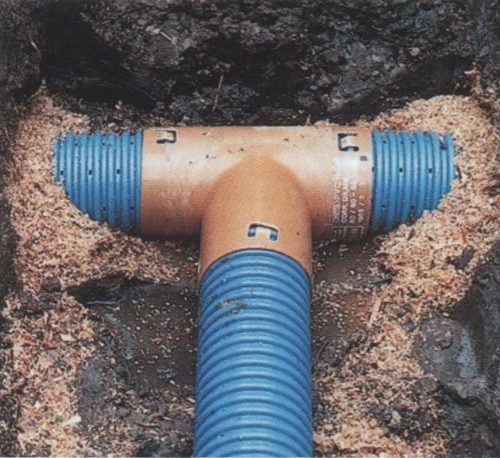

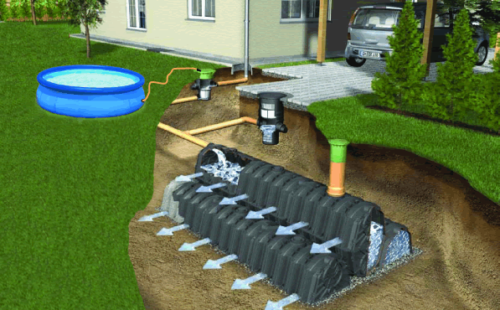
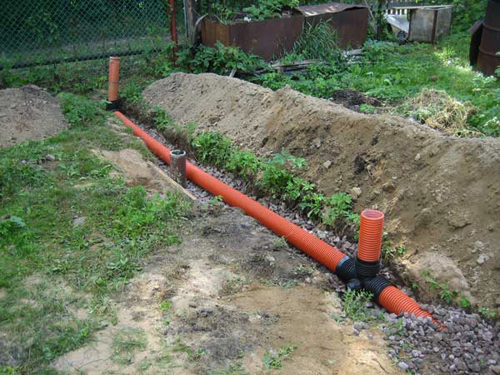
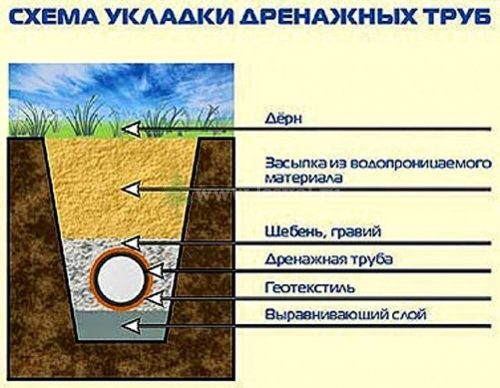
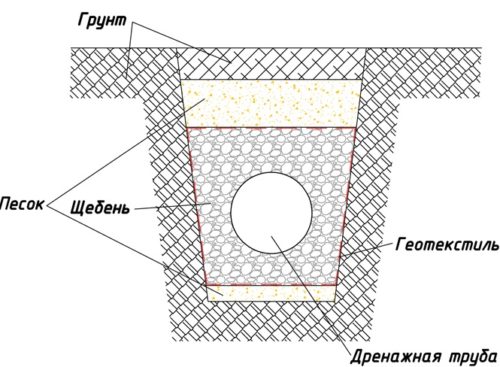
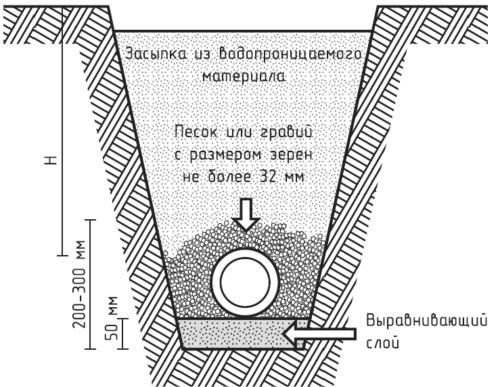
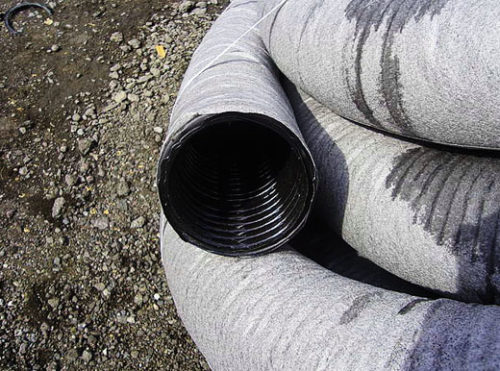


















We recommend using the services of professionals who are engaged in drainage sewage sections for more than 10 years. - https: //xn--80ahqp0afz7a3a.xn--p1ai/inzhenernye-sistemy-ograzhdeniya/ustrojstvo-drenazha/drenazhnaya-kanalizaciya-kupit-v-moskve-i-moskovskoj-oblasti/ Drainage sewage testing from 800 r per m